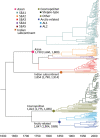Animal Rabies Surveillance, China, 2004-2018
- PMID: 33219645
- PMCID: PMC7706947
- DOI: 10.3201/eid2612.200303
Animal Rabies Surveillance, China, 2004-2018
Abstract
Rabies is a severe zoonotic disease in China, but the circulation and distribution of rabies virus (RABV) within animal reservoirs is not well understood. We report the results of 15 years of surveillance of the first Chinese Rabies Surveillance Plan in animal populations, in which animal brain tissues collected during 2004-2018 were tested for RABV and phylogenetic and spatial-temporal evolutionary analyses performed using obtained RABV sequences. The results have provided the most comprehensive dataset to date on the infected animal species, geographic distribution, transmission sources, and genetic diversity of RABVs in China. In particular, the transboundary transmission of emerging RABV subclades between China and neighboring countries was confirmed. The study highlights the importance of continuous animal rabies surveillance in monitoring the transmission dynamics, and provides updated information for improving current control and prevention strategies at the source.
Keywords: China; genetic diversity; rabies virus; surveillance; transboundary transmission; viruses.
Figures





Similar articles
-
Emerging New Phylogenetic Groups of Rabies Virus in Chinese Ferret Badgers.Biomed Environ Sci. 2018 Jun;31(6):479-482. doi: 10.3967/bes2018.064. Biomed Environ Sci. 2018. PMID: 30025563
-
Evolutionary dynamics of rabies viruses highlights the importance of China rabies transmission in Asia.Virology. 2011 Feb 20;410(2):403-9. doi: 10.1016/j.virol.2010.12.011. Epub 2010 Dec 30. Virology. 2011. PMID: 21195445
-
Large-scale phylogenetic analysis reveals genetic diversity and geographic distribution of rabies virus in South-East and South Asia.Infect Genet Evol. 2023 Sep;113:105472. doi: 10.1016/j.meegid.2023.105472. Epub 2023 Jun 22. Infect Genet Evol. 2023. PMID: 37353186
-
Rabies and rabies virus in wildlife in mainland China, 1990-2013.Int J Infect Dis. 2014 Aug;25:122-9. doi: 10.1016/j.ijid.2014.04.016. Epub 2014 Jun 6. Int J Infect Dis. 2014. PMID: 24911887 Review.
-
Reemerging rabies and lack of systemic surveillance in People's Republic of China.Emerg Infect Dis. 2009 Aug;15(8):1159-64. doi: 10.3201/eid1508.081426. Emerg Infect Dis. 2009. PMID: 19751575 Free PMC article. Review.
Cited by
-
Strategies to inTerrupt RAbies Transmission for the Elimination Goal by 2030 In China (STRATEGIC): a modelling study.BMC Med. 2023 Mar 16;21(1):100. doi: 10.1186/s12916-023-02821-x. BMC Med. 2023. PMID: 36927437 Free PMC article.
-
Evaluation of Vaccination Strategy Against Rabies in Hong Kong Macaques.Front Vet Sci. 2022 Mar 21;9:859338. doi: 10.3389/fvets.2022.859338. eCollection 2022. Front Vet Sci. 2022. PMID: 35372557 Free PMC article.
-
First isolation of rabies virus from a Eurasian badger (Meles meles) in Inner Mongolia, China, 2024.Front Vet Sci. 2025 Jun 25;12:1598528. doi: 10.3389/fvets.2025.1598528. eCollection 2025. Front Vet Sci. 2025. PMID: 40636809 Free PMC article.
-
Molecular analysis and geographic distribution of the recent Indonesian rabies virus.Vet World. 2023 Dec;16(12):2479-2487. doi: 10.14202/vetworld.2023.2479-2487. Epub 2023 Dec 25. Vet World. 2023. PMID: 38328351 Free PMC article.
-
Holistic application of the one health approach in the prevention and control of rabies: plausible steps towards achieving the 2030 vision in Africa.One Health Outlook. 2024 Sep 11;6(1):22. doi: 10.1186/s42522-024-00108-6. One Health Outlook. 2024. PMID: 39261974 Free PMC article. Review.
References
-
- Swanepoel R. Rabies. In: Coetzer JAW, Tustin RC, editors. Infectious disease of livestock: with special reference to southern Africa, 2nd ed. Cape Town (South Africa): Oxford University Press South Africa; 2004. p. 1123–82.
-
- National Health Commission of the People’s Republic of China. General situation of national legal infectious diseases [cited 2020 Apr 13]. http://so.kaipuyun.cn/s?token=9762&siteCode=bm24000006&qt=%E6%B3%95%E5%A...
-
- Meng S, Sun Y, Wu X, Tang J, Xu G, Lei Y, et al. Evolutionary dynamics of rabies viruses highlights the importance of China rabies transmission in Asia. Virology. 2011;410:403–9. - PubMed
-
- Ministry of Agriculture and Rural Affairs of the People’s Republic of China. Official veterinary bulletin [cited 2020 Apr 13]. http://www.moa.gov.cn/gk/sygb/
Publication types
MeSH terms
LinkOut - more resources
Full Text Sources
Medical

